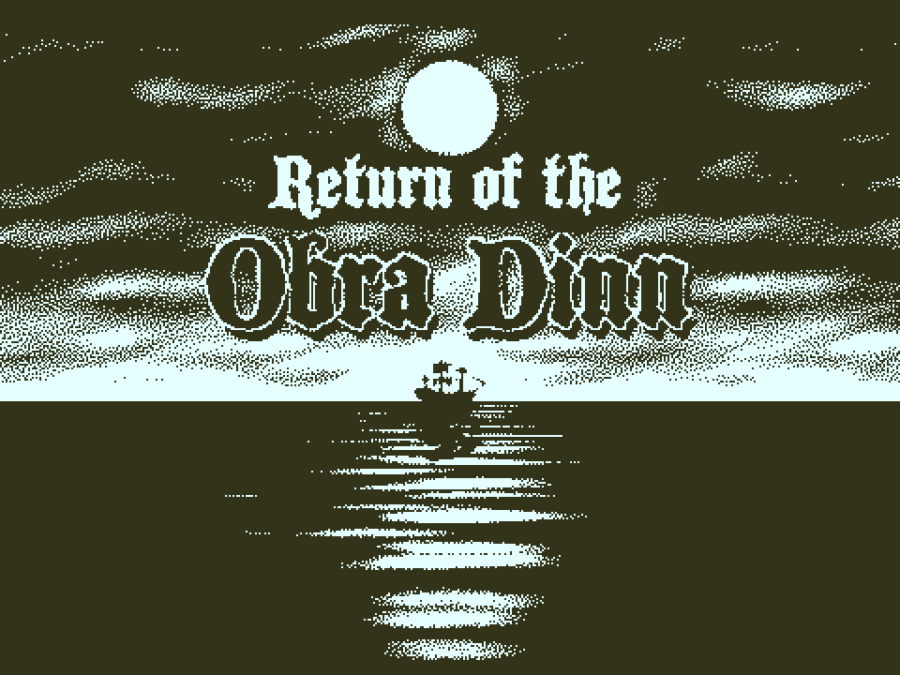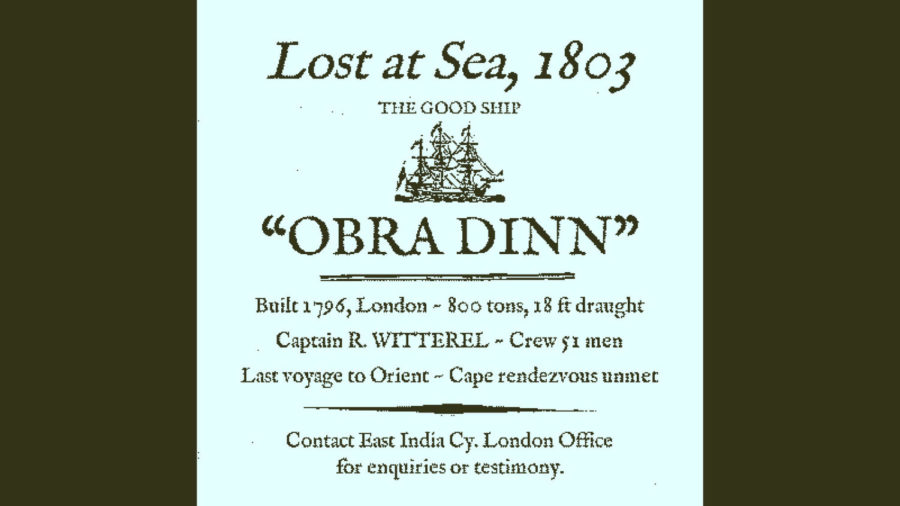I don’t game much, I’d go as far to say I’m not nearly one would classify as a “gamer.”
But I appreciate art. One’s expression of one’s self, heart, and passion. The end product of that will more often than not be a spectacular, unique masterpiece that defies expectations. And when it is, the creator is most likely a talented and creative individual.
Lucas Pope’s “Return of the Obra Dinn” is one such work, and Pope is one such fellow.
I was already familiar with Pope’s knack for creative invention and quality work, having experienced his previous and first commercial game, Papers Please.
He had set the bar high for himself when he released that title in 2013, but Pope somehow surpassed his own lofty standards and went above and beyond in his 2018 game.
“Return of the Obra Dinn,” similarly to “Papers Please,” succeeded in beautifully weaving an engaging narrative into unconventionally designed core gameplay, all the while displaying itself in a unique artistic style and motif.
Pope’s games represent the fundamental contrast in principle between independent developers and commercial corporations, between artwork and consumer product. When one creates as themselves, their passion and motivation drives their work the way no amount of profits can drive a commercial industry to. With year after year of the unstoppable tide of AAA titles taken by huge corporations that clearly give little care for their product, it’s refreshing to see the indie game developer community flourishing with ideas and inspiration.
But enough, let’s talk about the bare product itself.
Return of the Obra Dinn’s premise is as follows: In 1803, the East India Company trading vessel Obra Dinn fails to meet its rendezvous at the Cape of Good Hope in Africa and is soon declared lost at sea. After four years, the ship mysteriously drifts back into English waters, with all 60 souls on board dead or missing. As an insurance adjuster dispatched by the East India Company, you must board the Obra Dinn and investigate the fate of every individual on board, equipped with only a crew/passenger manifest and a few rough sketches of life on the ship. Also included is a magic pocket watch that allows you to relive the last few seconds of every corpse you encounter.
The game’s tagline itself epitomizes the striking quirkiness consistently seen in Pope’s work: “An Insurance Adventure with Minimal Colour.” It could’ve just been an interesting concept about solving mysteries through death freeze-frames, but instead there had to be that bizarre layer of pragmatic background: Hey, I may be using a magic pocket watch to travel through time like nobody’s business, but I’m merely here because my career as an insurance investigator is on the line, dammit!
What I truly commend and respect Pope for is his attention to detail in Obra Dinn. Every single aspect was carefully and meticulously crafted with love and ambition.
His keen visual design created a rich tapestry of themed aesthetics. From rough sketches mimicking illustration styles of the period to the use of printing press style fonts, Pope made sure the player felt they traveled back to the Georgian period of Britain, a time where the British Empire grew ever more powerful, where the Industrial Revolution lay distantly on the horizon, and where Asia was still referred to as “The Orient.”
Pope’s practical and crafty ingenuity shined in his decision to design the game’s graphics in a one-bit monochromatic style. This gave him a workaround from having to render complete 3D models, while bringing great flair to the visual atmosphere of the game itself.
He also challenged himself to solve the issue of visual legibility in his retro monochromatic world, one he solved with the quite satisfying application of black and white dithering and halftones. The narrative’s historical setting fusing with the game’s retro graphics gave an odd sense of nostalgic feeling.
His own compositions of the soundtrack were more than adequate in conveying atmosphere and accompanying the game, and his own sound design was impressive even by the standards of professional Foley work. The convincing voice-acting throughout the game was equally spectacular.
It’s the little details, all of this, that add up and truly immerse the player in the experience.
Pope’s clever storytelling and gameplay mechanisms paralleled the visual and audio work. You rush to solve the identities of the deceased before you and progress in the mystery, simply because you’re drawn into discovering more about the tragic story of the ship’s journey. The story becomes less and less incomplete the more you investigate the puzzles before you.
The game is a hardy test of your ability of logical deduction in its purest form, as it presents scraps of clues for you to ponder through at each turn. The core gameplay mechanics are, in true Lucas Pope fashion, unique, unconventional, and an invention of his own. The straightforward gameplay itself is simply consisted of recording each identity and their corresponding fate. Like so, you fill out the pages of your assessment logbook procedurally, as if it was everyday paperwork to you. And to me personally, this was Obra Dinn’s most wonderful feature. I can sit down, and convincingly immerse myself in the protagonist’s position, exploring and experiencing the mystery just as they are.
Lucas Pope’s “Return of the Obra Dinn” succeeds at being a video game in all possible ways. Obra Dinn has transcended expectations wildly as an independent project while simultaneously being a simple, fun experience.
A free demo is available on Lucas Pope’s website, and I strongly suggest anyone who enjoys thinking, looking at pretty things, and/or insurance claim investigations involving spooky ghost ships to take a gander.



